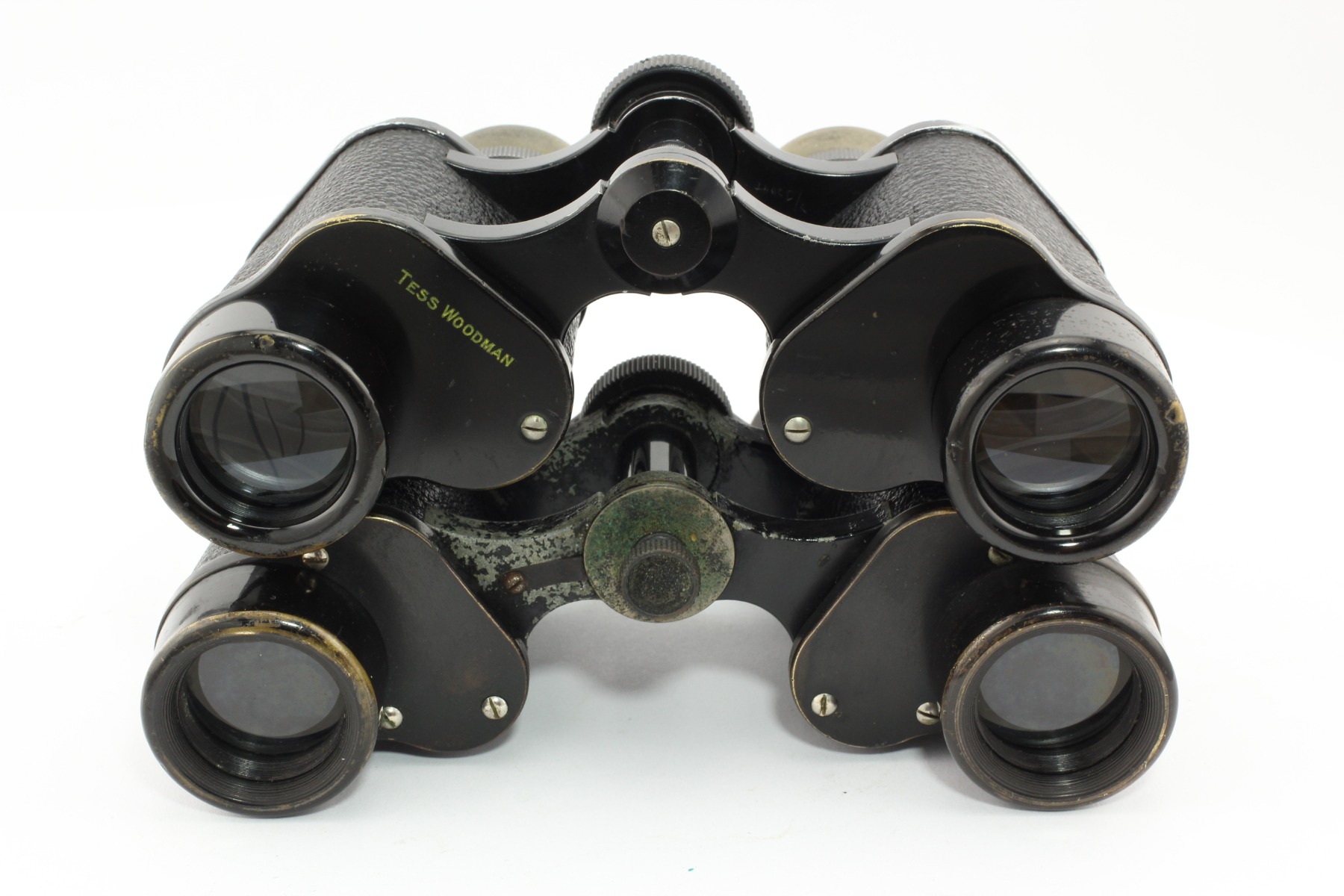Magnification: 6x
Aperture (objective diameter): 24 mm
Field of view: 8.5°
Visible field of view (eyepiece): 51°
Outlet pupil diameter: 4 mm
The closest focusing distance:3.5 m
Width: 15.6 cm
Height: 10 cm
Weight: 535 g
Production date: 1926.
Binocular Carl Zeiss Jena Telexem 6x24
Binoculars with central focusing appeared on the market in the middle of the 19th century. Carl Zeiss engineers were not in a hurry with such devices’ production, since they considered them less reliable and protected from dust and dirt. First prototypes of these binoculars were produced in Jena back in 1907, but only in 1909/1910 Carl Zeiss was forced to begin mass production of the devices of such design under the competitors’ pressure and because of the demand. First models of central-focus binoculars appeared in T136 catalog in 1910–those were Teletur 6x15, Telexem 6x21, Telactem 8x24 and Silvarem 6x30. Subsequently, all civilian Carl Zeiss binoculars with central focusing had an “...em” ending in their designations.
The first Telexem models’ objective diameter was equal to 21 mm and since 1911/12 –it was 24 mm. Since 1921 the binoculars’ field of view was increased from 6.8° to 8.5°.
The binocular “civilian” use is proved by central focusing mechanism (military models were never produced with it).There is an interpupillary distance scale on the upper hinge disc. The diopter scale is plotted on the central focusing flywheel (the first models did not have it). The right eyepiece has its own focusing mechanism with a diopter scale.
This device belongs to later version (with an objective equal to 24 mm), having rounded objective covers. The eyepieces grooves (knurling) are located along the binoculars’ optical axis. The upper prism cover width is equal to49 mm (this value was equal to 45.5 mm in previous version of this model); the binoculars’ height from the lens frames’ lower cut to the upper prism cover is equal to 69 mm. The prism covers are attached to the housing with the help of one screw (there were three screws in the previous version http://binocollection.com/catalog/binoculars-carl-zeiss-jena-telexem-6x.html ). The eyepieces’ base diameter is equal to 24 mm(this value was equal to 20.5 mm in previous version of this model). The binocular’s field of view is 8.5° (it was equal to 6.8° in the previous version). The eyepieces’ housing and the eyecup design were also changed (see photo).




There are inscriptions “Carl Zeiss Jena Jena” on the left prism cover. There is also an inscription “Telexem 1309732 6x24” on the right prism cover. The inscription is made in block letters against the background of Carl Zeiss Tessar photo lens schematic image. There is also an inscription “Tess Woodman” on the right prism cover.
The binocular’s coffer has features peculiar to “civilian” models of that period (see Hans T. Seeger. Zeiss Handfernlaser 1919-1946, Modelle-Merkmale-Mythos, pp. 607-627). Initials of the binoculars’ owner T.E.W. (Tess Woodman) are encrusted on the coffer top cover.
The device’s serial number is 1309732 and it was produced in 1926.
Version with the two-ring type lens frames - http://binocollection.com/catalog/binoculars-carl-zeiss-jena-telexem-6x-1.html .
Telex is the separate focusing binocular with similar characteristics - http://binocollection.com/catalog/binoculars-carl-zeiss-jena-telex-6x24.html.
Around 1935 Telexem was replaced by the new model – namely, Sportur.
The first Telexem models’ objective diameter was equal to 21 mm and since 1911/12 –it was 24 mm. Since 1921 the binoculars’ field of view was increased from 6.8° to 8.5°.
The binocular “civilian” use is proved by central focusing mechanism (military models were never produced with it).There is an interpupillary distance scale on the upper hinge disc. The diopter scale is plotted on the central focusing flywheel (the first models did not have it). The right eyepiece has its own focusing mechanism with a diopter scale.
This device belongs to later version (with an objective equal to 24 mm), having rounded objective covers. The eyepieces grooves (knurling) are located along the binoculars’ optical axis. The upper prism cover width is equal to49 mm (this value was equal to 45.5 mm in previous version of this model); the binoculars’ height from the lens frames’ lower cut to the upper prism cover is equal to 69 mm. The prism covers are attached to the housing with the help of one screw (there were three screws in the previous version http://binocollection.com/catalog/binoculars-carl-zeiss-jena-telexem-6x.html ). The eyepieces’ base diameter is equal to 24 mm(this value was equal to 20.5 mm in previous version of this model). The binocular’s field of view is 8.5° (it was equal to 6.8° in the previous version). The eyepieces’ housing and the eyecup design were also changed (see photo).
There are inscriptions “Carl Zeiss Jena Jena” on the left prism cover. There is also an inscription “Telexem 1309732 6x24” on the right prism cover. The inscription is made in block letters against the background of Carl Zeiss Tessar photo lens schematic image. There is also an inscription “Tess Woodman” on the right prism cover.
The binocular’s coffer has features peculiar to “civilian” models of that period (see Hans T. Seeger. Zeiss Handfernlaser 1919-1946, Modelle-Merkmale-Mythos, pp. 607-627). Initials of the binoculars’ owner T.E.W. (Tess Woodman) are encrusted on the coffer top cover.
The device’s serial number is 1309732 and it was produced in 1926.
Version with the two-ring type lens frames - http://binocollection.com/catalog/binoculars-carl-zeiss-jena-telexem-6x-1.html .
Telex is the separate focusing binocular with similar characteristics - http://binocollection.com/catalog/binoculars-carl-zeiss-jena-telex-6x24.html.
Around 1935 Telexem was replaced by the new model – namely, Sportur.
